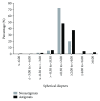Refraction and Ocular Biometry of Preschool Children in Shanghai, China
- PMID: 29692930
- PMCID: PMC5859869
- DOI: 10.1155/2018/5205946
Refraction and Ocular Biometry of Preschool Children in Shanghai, China
Abstract
Purpose: To investigate the refraction and ocular biometry characteristics and to examine the prevalence of refractive errors in preschool children aged 3 to 6 years in Shanghai, China.
Methods: A school-based cross-sectional study was conducted in Jiading and Xuhui District, Shanghai, in 2013. We randomly selected 7 kindergartens in Jiading District and 10 kindergartens in Xuhui District, with a probability proportionate to size. The children underwent comprehensive eye examinations, including cycloplegic refraction and biometric measurements. Myopia, hyperopia, astigmatism were defined as spherical equivalent (SE) ≤ -0.50 D, SE ≥ +2.00 D, and cylindrical diopters ≤ -1.00 D.
Results: The mean SE for 3- to 6-year-old children was +1.20 D (standard deviation [SD] 1.05), and the mean axial length (AL) was 22.29 mm (SD 0.73). The overall prevalence of myopia and astigmatism was 3.7% and 18.3%, respectively. No difference in prevalence of astigmatism was found across age groups. There was a statistically significant association between lower cylindrical diopters and higher spherical diopters (Spearman's correlation: -0.21, P < 0.001).
Conclusion: Chinese children aged 3 to 6 years in the Shanghai area were mostly mildly hyperopic, with a low prevalence of myopia. Refractive astigmatism for children may be relatively stable throughout the preschool stage. Astigmatism was significantly associated with refractive error.
Figures
References
LinkOut - more resources
Full Text Sources
Other Literature Sources



